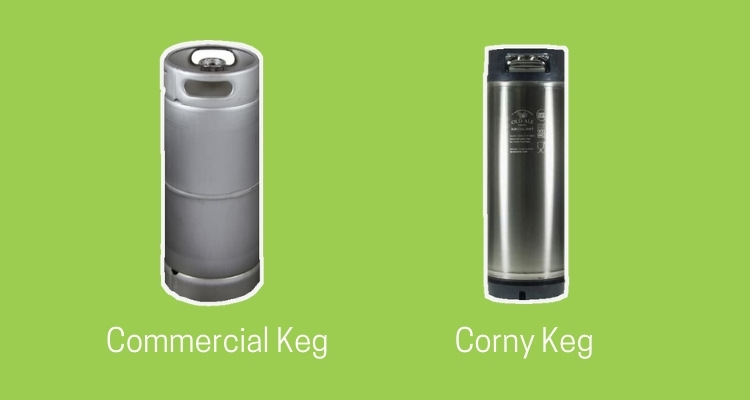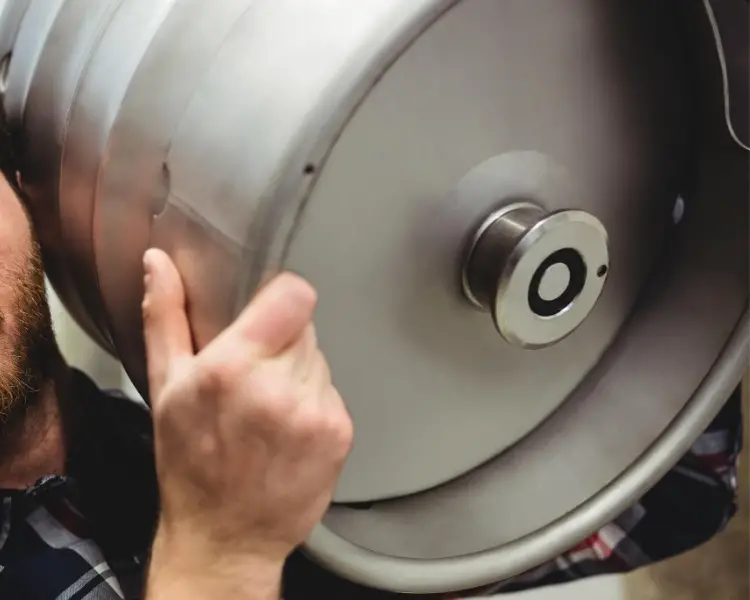If you’re a big fan of beer and homebrew, then commercial kegs have probably crossed your mind a few times. When people think of kegs, they think of distilleries and bars, and a large party. But if you are frequently brewing your beverages at home, a larger container might make more sense. Here’s the information you need to know on commercial kegs at home.
Commercial kegs can be used for homebrew. Reasons like having to lift a heavy keg might make some may shy away from commercial kegs. But there are no reasons that prevent you from physically being able to use a commercial keg for your home brewing activities.
However, using a commercial keg requires extra effort and some additional thought when adding it into your homebrew kit.
Consider things like:
- Weight & maneuverability
- Fermentation
- Cleaning
These are all factors that you should take into account when making your decisions about your commercial keg.
Differences between Corny kegs and commercial kegs

Homebrew kegs are typically referred to as Corny’s or Cornelius kegs.
They differ in a few ways from commercial kegs such as size, price, the way they work.
To better understand how you can use a commercial keg in your homebrew efforts, we must understand these differences and know the benefits and cons that come with them.
Size
Commercial kegs come in four different sizes for all different needs.
Below is a chart breakdown of dimensions with the four sizes explained in more in-depth.
| Size/Model | Dimensions | How much it holds |
| Sixth Barrel | 23.3” x 9.25”D | 5.16 gallons / 55 -12oz. beers |
| Short/Quarter Barrel | 14.8” x 16.125”D | 7.75 gallons / 82 -12oz. beers |
| Slim/Sixth Barrel | 23.3” x 11.125”D | 7.75 gallons / 82 -12oz. beers |
| Half Barrel | 23.3” x 16.125”D | 15.5 gallons / 165 -12oz. beers |
Sixth Barrel
Close in size to the Corny keg this size is best for personal use but a tiny bit bigger.
Best used to dual or triple-tag kegerators.
Best for small spaces.
Sometimes this size can also be referred to as the Torpedo, Log, or Sixtel.
Short/Quarter Barrel
Good for small parties this keg is wide and short, unlike the sixth.
It’s as wide as a full barrel and can hold up to 82 bottles of beer.
Its nicknames are Stubby Keg or Pony Keg.
Slim Quarter Keg
Also holding 82-12 ounce bottles of beer, this design is as the name says.
Tall and slim.
It’s basically a bigger sixth barrel for those who want to do the dual-tap kegerator.
This is also a good size for small parties.
Half Barrel Keg
No products found.
This is the party keg you think of when someone says keg stand.
These are used for large events, big bars and restaurants, and sometimes homebrew if you are producing a mass amount of beer.
Doubling how much it can hold from some of the others, this barrel is the largest.
The Tops
Homebrew kegs like the Corny have different tops then commercial kegs.
Within this category itself, there are two standard sizes that we can get into.
There is the pin lock and the ball lock.
But before we get into that, understand that homebrew kegs (not commercial) have large removable lids.
This makes it easy because:
- The owner can remove the lid with ease to sanitize/clean the inside. Cleaning must happen every use, so this can be a major factor in choosing the Corny over the commercial keg.
- The owner can fill the keg with the beverage easily. Sometimes homebrewers don’t want to go through the hassle of filling it without easy lid removal.
Cleaning the other types of kegs can be a little more difficult and time-consuming, which is why some home brewers stay away from commercial kegs.
It’s usually another investment to have the right sanitizing tools that fit into these types of kegs.
The other variance between the Corny keg and commercial is that they have two posts on top compared to the one in the center of the commercial keg. This is because one is meant to allow the CO2 in for carbonation while the other is meant to pour the beer out.
Cornelius Keg Locks
There are two main locks when it comes to the Corny kegs.
Those are pin locks and ball lock kegs.
These go with the standard five-gallon Corny Kegs.
There is a difference between the two.
1) Pin Lock
This type of lock trend on the cheaper side and typically easier to come across. It’s recommended that if you are just brewing at home and plan to leave it their then pin lock is the way to go. Pin locks have to stubs on either end for the disconnects. You can’t really go wrong with the connection.
2) Ball Lock
On the contrary, these are harder to find and run typically at more expensive prices. That being said, if you are planning on sharing and traveling with your brew, then this is the recommended option. While it’s easier to mess up the connection, these locks, most of the time, have a pull-pin pressure relief where pin locks do not.
Downsides of commercial kegs
Having said that, there are some risks and complications that one might want to consider when crossing over into the world of commercial kegs.
Size is still an important factor, along with weight and maneuverability.
Costs also play a roll in which keg you want to buy.
Below are some of the complications you may run into with commercial kegs.
1- Costs
Corny kegs typically cost about $90-100 on Amazon with some half-barrel kegs ranging around $110 – 125 on Amazon.
Costs aren’t a huge difference when it comes to size.
The costs come from cleaning it.
As mentioned before, with a Corny, you can remove the lid and clean it yourself.
But with a commercial, the process can be tougher, with the only opening being at the top.
This requires extra tools and extra costs.
2- Maneuverability
Sometimes common sense can get the better of us.
The larger the barrel, the heavier it will be once full.
If you plan on moving your keg to and form a lot of places, then the half-barrel keg is not going to be a solid option.
3- Storage
Along with considering the size of a keg, you should consider your storage availability.
Kegs are not the most attractive looking piece of decoration going.
Depending on the size you buy will require a certain amount of space for where you are fermenting and brewing everything.
This is one of the main factors for beginner home brewers in choosing a smaller option for kegs.
Personal Preference
So the answer to the main question is yes, you can use commercial kegs for home brewing.
Where the answer varies is how often, how much you brew, and whether you are going to bring it places, or keep the keg at home.
The other factor is whether you are a novice or an expert at brewing.
The farther you get down the line of commercial kegs, the more information you will need to know about cleaning and handling them whereas the Corny kegs try and make life easy on you if you treat it like a hobby.
But as far as the possibility of commercial kegs, the sky is the limit and there is something out there for individual preferences thing out there for individual preferences and needs.
Last update on 2025-04-20 / Affiliate links / Images from Amazon Product Advertising API
